
Radical re-conception and revelatory re-casting add up to a revolutionary 21st-century take on Sherman Edwards and Peter Stone’s 1969 Broadway classic 1776 in the 2022 Broadway revival now thrilling audiences at the Ahmanson.
To begin with, there’s not a cisgender white male in sight, a far cry from the Broadway original and just about any other 1776 that’s been staged over the past sixty-four years.
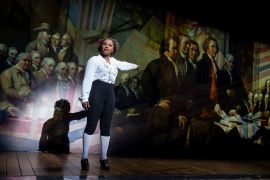 Directors Jeffrey L. Page and Diane Paulus signal their intentions from the moment the lights go up on a proscenium-wide portrait of the men who signed the Declaration of Independence on July 4, 1776, colonial gents whose likenesses Gisela Adisa’s John Adams gazes up at in dismayed disbelief at who’s missing in the group.
Directors Jeffrey L. Page and Diane Paulus signal their intentions from the moment the lights go up on a proscenium-wide portrait of the men who signed the Declaration of Independence on July 4, 1776, colonial gents whose likenesses Gisela Adisa’s John Adams gazes up at in dismayed disbelief at who’s missing in the group.
Where are the women? Where are the people of color?
The answer is revealed when the curtain parts to reveal twenty or so performers whose pronouns are either she/her, she/they, or they/them donning 18th-century menswear to put on a show in which they at long last are the stars.
As in past 1776’s, the first of Edwards’ dozen melodious, memorable songs has the “obnoxious and disliked” future second president being told to “For God’s Sake, John, Sit Down,” though this time round Adams is being brought to life by an African American woman, and those doing the asking are playing real-life historical figures as well, albeit though a decidedly different lens.
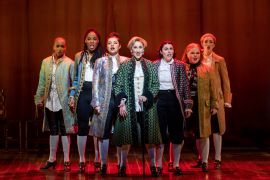 They include Ben Franklin (Liz Mikel), the inventor of the stove and countless bons mots still quoted today; Thomas Jefferson (Nancy Anderson), who finds himself pressured to go against his deepest convictions to get his Declaration passed unanimously; the very full-of-himself Richard Henry Lee (Shawna Hamic), whose “The Lees Of Old Virginia” comes with its own built-in encore; proud Southern gentleman Edward Rutledge (Kassandra Haddock), eager to rebuke his New England colleagues for the “aroma of hypocrisy floating down from the North”; and John Dickenson (Joanna Glushak), the proudly pro-monarchy delegate from Pennsylvania.
They include Ben Franklin (Liz Mikel), the inventor of the stove and countless bons mots still quoted today; Thomas Jefferson (Nancy Anderson), who finds himself pressured to go against his deepest convictions to get his Declaration passed unanimously; the very full-of-himself Richard Henry Lee (Shawna Hamic), whose “The Lees Of Old Virginia” comes with its own built-in encore; proud Southern gentleman Edward Rutledge (Kassandra Haddock), eager to rebuke his New England colleagues for the “aroma of hypocrisy floating down from the North”; and John Dickenson (Joanna Glushak), the proudly pro-monarchy delegate from Pennsylvania.
Even in its original, much replicated incarnation, 1776 risk-takingly flouted musical theater conventions.
Debate sequences are entirely song-free. Several characters show up for a single solo, then vanish, never to return. And rarely has a roll call been more edge-of-your-seat thrilling than the one that brings 1776 to its heart-stirring close.
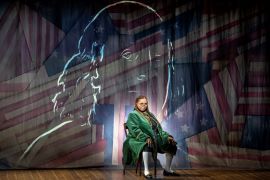 Still, these innovations pale in comparison to those of Page, Paulus, and a design team who eschew a realistic setting for something at once far simpler (the stage is backed by plain brown drapes that extend less than halfway up the proscenium arch) and far more theatrical, particularly where lighting and projections are concerned.
Still, these innovations pale in comparison to those of Page, Paulus, and a design team who eschew a realistic setting for something at once far simpler (the stage is backed by plain brown drapes that extend less than halfway up the proscenium arch) and far more theatrical, particularly where lighting and projections are concerned.
There’s a good deal more choreography (by co-director Page) this time round, and three post-intermission showstoppers have been reimagined to stunning effect.
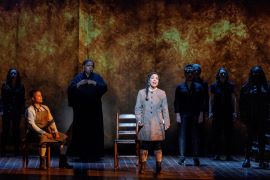 A messenger’s heartbreaking “Momma, Look Sharp,” a song that customarily ends Act One with a single performer on stage, has been moved to Act Two with the Courier (Brooke Simpson) now backed by a chorus of mothers grieving the loss of their sons to battle.
A messenger’s heartbreaking “Momma, Look Sharp,” a song that customarily ends Act One with a single performer on stage, has been moved to Act Two with the Courier (Brooke Simpson) now backed by a chorus of mothers grieving the loss of their sons to battle.
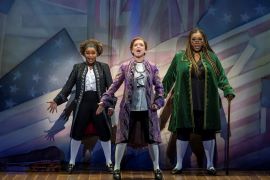 “The Egg,” which has Franklin, Adams, and Jefferson comparing the creation of a new nation to the hatching of a bird, now closes with barrage of projected snapshots of two-and-a-half centuries of American turmoil and change.
“The Egg,” which has Franklin, Adams, and Jefferson comparing the creation of a new nation to the hatching of a bird, now closes with barrage of projected snapshots of two-and-a-half centuries of American turmoil and change.
Lastly, “Molasses To Run,” a song that has South Carolina delegate Rutledge condemning the convention’s anti-slavery contingent for profiting from the practice now features black cast members assembled as their ancestors once were—on the auction block.
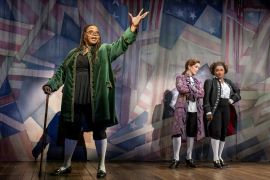 If it’s not already clear, this is a 1776 unlike any before, and very much what I was wishing for when I saw the musical revived in 2017 with an almost entirely diversity-free cast at a time when “making America great again” basically meant making American white again.
If it’s not already clear, this is a 1776 unlike any before, and very much what I was wishing for when I saw the musical revived in 2017 with an almost entirely diversity-free cast at a time when “making America great again” basically meant making American white again.
Performances on the Ahmanson stage may be a good deal broader than in a traditional 1776, but they are valid choices given the revival’s putting-on-a-show conceit, and simply hearing Sherman’s songs performed for the first time by sopranos and altos is a joy unto itself.
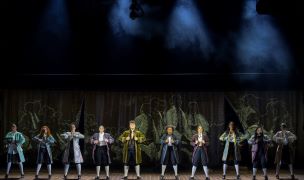 I could go on and on about how excitingly acted and sung each individual role is in this nationally touring cast (completed by Connor Lyon and Tieisha Thomas (as both delegates and delegate’s wives, Shelby Acosta, Tiffani Barbour, Dawn Cantwell, Julie Cardia, Anissa Marie Griego, Nykila Norman, Oneika Phillips, Lulu Picart, Ariella Serur, Sav Souza, Gwynne Wood, and Candice Marie Woods) but in the interest of brevity, I’ll simply say that there’s not a less than thrilling link among them.
I could go on and on about how excitingly acted and sung each individual role is in this nationally touring cast (completed by Connor Lyon and Tieisha Thomas (as both delegates and delegate’s wives, Shelby Acosta, Tiffani Barbour, Dawn Cantwell, Julie Cardia, Anissa Marie Griego, Nykila Norman, Oneika Phillips, Lulu Picart, Ariella Serur, Sav Souza, Gwynne Wood, and Candice Marie Woods) but in the interest of brevity, I’ll simply say that there’s not a less than thrilling link among them.
The same can be said about the groundbreaking contributions of scenic designer Scott Pask, costume designer Emilio Sosa, lighting designer Jennifer Schriever, sound designer Jonathan Deans, projection designer David Bengali, and musical supervisor/music director Ryan Cantwell.
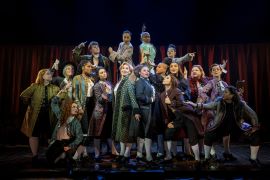 Theatergoers hidebound by tradition might find it hard to see beyond preconceived notions where Jeffrey L. Page and Diane Paulus’s 1776 is concerned, and if so, the loss will be theirs.
Theatergoers hidebound by tradition might find it hard to see beyond preconceived notions where Jeffrey L. Page and Diane Paulus’s 1776 is concerned, and if so, the loss will be theirs.
Those willing to experience a sixty-four-year-old musical with new eyes and open minds will be as dazzled as they are moved to cheers.
Ahmanson Theatre, 135 N Grand Ave, Los Angeles.
www.CenterTheatreGroup.org
–Steven Stanley
April 12, 2023
Photos: Joan Marcus
Tags: Ahmanson Theatre, Center Theatre Group, Los Angeles Theater Review, Peter Stone, Sherman Edwards


 Since 2007, Steven Stanley's StageSceneLA.com has spotlighted the best in Southern California theater via reviews, interviews, and its annual StageSceneLA Scenies.
Since 2007, Steven Stanley's StageSceneLA.com has spotlighted the best in Southern California theater via reviews, interviews, and its annual StageSceneLA Scenies.







 COPYRIGHT 2024 STEVEN STANLEY :: DESIGN BY
COPYRIGHT 2024 STEVEN STANLEY :: DESIGN BY